Engraving and etching
Several correspondents asked for help understanding how some of the fabulous engravings in our hobby were created, I transcribed part of chapter 1 from a book written in 1914 which I think gives an excellent description of the engraving and etching process. The numbers you will see throughout the text refer to hand-drawn illustrations included in that book and reproduced here.
Modern reprint editions of this classic book are available. Check Amazon, Abe Books, and similar sources. Antique versions are also available on occasion. Try Alibris.com and Abe Books.
A History of Engraving and Printing from the 15th Century to the year 1914, being the third and fully revised edition of “A Short History of Engraving and Etching
by Arthur M. Hind, 1923, Houghton Mifflin Company.
Our subject then is limited to then type of engraving on metal in intaglio, where the lines or spaces engraved serve as the design, which, except in occasional instances, figure as black on white, or at least as a darker tone on a lighter tone. Gravure en taille-douce it is called in French, a term perhaps implying the joy of the craftsman in engraving the line which is to be the design in itself, rather than a mere negative value to be laboriously removed.
For a true appreciation of prints, which form the chief material for our study, it is essential to understand the main principles of the various processes by which plates may be engraved. A description of these processes, in just sufficient detail to enable the student of the history of engraving to obtain a proper comprehension of cause and effect, is the aim of the present chapter.


Graver (aka burin)
The essential element of the graver or burin (1), the chief instrument of the line-engraver, is a small steel rod some four or five inches long, the shape of whose section is either square or lozenge (1a and 1b), with cutting point and edges gained by sharpening the head in an oblique section. The most usual form of handle is as in 1, but it is not infrequently shaped as in 2. The plates used in engraving are generally of copper, well beaten and of highly polished surface. Zinc, iron, silver, steel, brass and even pewter plates have occasionally been used, iron and zinc less frequently for line-engraving than etching, where the artist may choose these materials to achieve a rougher result. Steel was largely used in the second quarter of the last century for line-engraving, etching and mezzotint. The more recently applied method of steel-facing by electrolysis, which imparts an equal durability to the copper, has almost entirely superseded the use of plates of a metal whose toughness presents greater difficulties to the engraver. Steel-facing is now frequently used when a large number of impressions are to be taken for some commercial purpose, but most artist-engravers and etcher prefer to limit their editions to the number that can be obtained from the copper. Whether the purity of the line is more than microscopically impaired by the process is a matter on which opinions are divided.
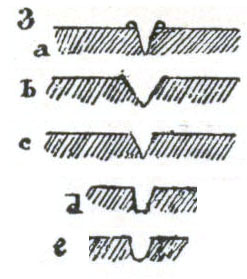
Magnified cross-sectional view of engraved lines
The engraver grasps the blade of the graver between the thumb and first or second finger (in the latter case letting the first finger fall along the top of the blade), holding the round part of the handle against the palm. He then presses the point of the graver into the surface of the plate, which is laid on a pad to facilitate its turning, being careful to keep the two sides of the graver at equal angles to the plate's surface. The resultant incised line will exhibit a curl at either side (if regularly engraved) as in 3a, but this will be very slight if the graver is perfectly sharpened. This roughness, called burr, is removed by the scraper (18: an instrument with triple and fluted blade, very finely sharpened), leaving a clean furrow as in 3b and 3c according to the shape of the graver used (1a or 1b). Another tool similar to the ordinary graver, but with a triangular section (though sometimes slightly curved on the upper side) called the tint-tool (2 and 2a), is more especially a wood-engraver's instrument, used for cutting series of fine lines so as to get the tone or “tint” from which it derives its name. Sharpened with a square or round belly (2b and 2c), after the manner of what is termed a scorper (scauper or scooper), it may serve the metal engraver for his broader lines. The ordinary lozenge graver is also sometimes sharpened in a similar way (1c and 1d)). Except in its flattest shape, that of the gouge, which is used to scoop out parts of the plate to be erased, these scorper forms are much less used by the artist-engraver than by the heraldic and letter engraver. More particularly a craftsman's instrument again is the threading-tool (2d). A shape similar to the tint-tool, with broad flat belly, is threaded on is lower surface to facilitate the engraving of parallel lines.
 Cross-sectional view of scraped mezzotint
Cross-sectional view of scraped mezzotint
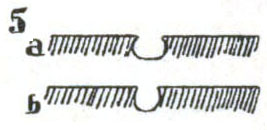 Cross-sectional view of etched lines
Cross-sectional view of etched lines
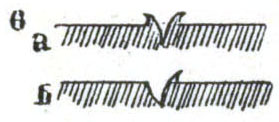 Cross-sectional view of dry point lines
Cross-sectional view of dry point lines
Throughout our description of the various tools it must be remembered that while, as far as possible, the conventional forms are given, variations of shape may occur according to the discretion of the engraver.
 Stipple graver
Stipple graver
To make a line of thickness varying in its own length, the engraver deepens his cutting, or leans the graver on one side; the latter only if swelling required to be slight, as otherwise the irregular furrow with a sloping side thus formed would fail to hold the ink adequately. If greater variation in breadth is required, he must cut further lines alongside his original furrow. In close shading dots may be made by the point of the graver and short lines, called flicks, are often used, either by themselves for the lighter portions of the shading, or within the interstices of the cross-hatchings. The flicks are frequently made with the curved graver such as is used in stipple work. (7).
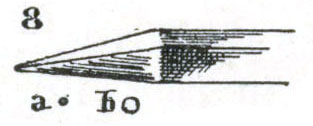
Dotting punch
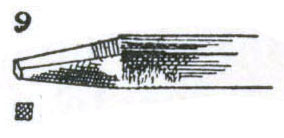
Matting punch
For the correction of work on the plate the method is as follows: The part of the surface wrongly engraved is removed by means of the scraper, or, if the lines are shallow, rubbed down with the burnisher, an instrument having an oval section and a rounded and highly polished edge (19). By means of the callipers (shaped as in 27a or 27b) the exactly corresponding part of the other side of the plate is located, and the indentation caused by the erasure is then knocked up from behind by a hammer (26), or if only a very limited space is to be corrected, with an ordinary flat punch (25a) and hammer. Occasionally, more particularly in the case of thick steel plates, a punch with a rounded head (called the cocking-punch) is used in conjunction with the hammer of the face of the plate, in such a manner as to beat down the sides of the engraved lines and close the cavity. The surface, being leveled with charcoal and polished with the burnisher, can be engraved as before. Light lines can also be worn down by rubbing with the oil-rubber (a roll of woolen cloth bound with a string, which is generally used merely with oil to clean and polish the plates (28) in conjunction with the finest emery (common called flour emery) or other polishing powder (e.g. fine crocus or rotten stone), emery being more suitable for steel, the two later powders for copper.
In etching, as the name implies, the line is obtained by corroding or "eating" the plate with some acid or mordant.
The plate, after being polished with the oil-rubber and sedulously cleaned with chalk or whitening, is covered with a thin layer of etching-ground, made with a mixture, in varying quantities, of different waxes, gums and resins. A harder ground, used largely by earlier etchers, but now quite discarded, contained similar ingredients (with the important exception of the virgin wax), combined with nut-oil.
The most common way of laying the ground is as follows: a ball of solid ground, brought into contact with the heated plate, melts and oozes through the porous silk in which it is kept wrapped. The substance thus melted is spread evenly over the plate by a succession of sharp blows with the dabber (30), a pad of some two or three inches in diameter covered with silk or kid. The grounded plate is then held over some lighted tapers, whose smoke is absorbed by the melted ground, making it black, a practice merely to aid the etcher to see the lines he is opening. With the idea of avoiding the negative nature of the design, which would thus appear as a bright copper red on a black ground, some etchers use means to cover the ground with white, so that their design will resemble red chalk on white paper.

Simple roulette
Two other methods of laying the ground may be mentioned. First by means of the roller (29). A mixture, of the consistency of a paste, of ordinary ground with oil of spike, is laid on a piece of plate glass. Over this the roller is passed, and covered with a uniform coating of the paste, which is then evenly rolled over the plate. The application of heat soon drives away most of the oil, but for a complete evaporation several days are necessary.
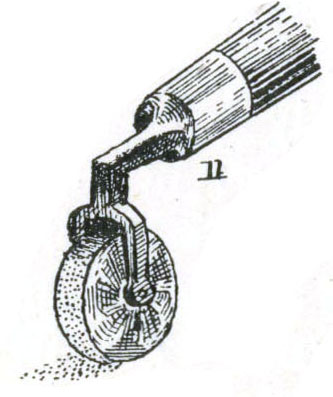
Chalk roll
By a third method the ground is dissolved in chloroform. The solution is poured over the plate, and the superfluous liquid run off. The chloroform dries very quickly, leaving the solid ground.

Matting wheel

Matting wheel
The artist-etcher will often work without the aid of any design laid on the surface of the ground. But if design is needed it can easily be transferred by covering the back of the thin paper, which contains the drawing, with red or other chalk, and pressing the design through onto the blackened ground. There are, of course, various other means, a pencil drawing on thin paper laid against the grounded plate and passed through the press being an expeditious method.

Etching needle

Oval point
To open up the lines the instrument used is what is called the etching needle, which is generally set in a simple holder as in 14. The needles, of course, vary in thickness, and are more or less sharply pointed according to need. Sometimes for thicker lines a broader needle, sharpened in an oval section (15) is used, though much less now than at the time of Callot and Bosse, and variation in width in the course of the line could be made by holding the point at varying angles, or by cutting more of less into the surface of the plate through the ground. Even the square and lozenge graver shapes (16) are also occasionally used by the etcher. The modern artist-etcher keeps, however, almost entirely to the simple form of needles, regarding the swelling and diminishing line, achieved by the oval point, as more suited to the less fluent art of line engraving.
There are three mordants in general use: dilute Nitric or Nitrous acid, dilute Hydrochloric acid mixed with Chlorate of Potash, i.e. what is called the Dutch Bath, and a solution of Perchloride of Iron. The last is least used by the artist-engraver, partly, no doubt, because of the difficulty of gauging its strength and action. It has been recently much employed for making process plates.
Nitric acid, which is the oldest mordant, works quickly and strongly, and has a tendency (which may be moderated by the admixture of sal-ammoniac) to attack each tide of the line, forming a rounded cavity as in 5a. The presence of bubbles facilitates the calculation of the time to be allowed for biting. The Dutch Bath (which is often used in conjunction with the preceding mordant to bit the more delicate lines) acts slowly and more directly downwards (biting a cavity as in 5b). No bubbles are visible in the action, so that its effect can only be judged by careful timing according to known strength of acid.
Perhaps the oldest method of applying the mordant was to build up a little wall of wax round the edge of the plate within which the acid could be poured as in a bath. This "damming process" must have been long in use among the goldsmiths.
Another early method described by Bosse (1645) is the arrangement of a large dish banked on three sides, and set at an angle so that the acid which is poured over the plate (previously protected at the back and edges by a coating of varnish) would constantly drain into a receptacle below. Except in a modified form introducing a spray, recently applied to the etching of process plates, this mode has quite fallen out of use. The process now generally adopted does not seem to have been introduced until the end of the 17th century, and probably found little favor until the beginning of the last century. The plate is protected at the back and edges with a coating of Brunswick black (or some other stopping out vanish), and then put into a bath of acid.
When the lightest lines are sufficiently bitten (the time required may vary from a few minutes to a few hours), the plate is taken out. If certain lines need to be etched more deeply, the others must now be covered with stopping-out varnish and the plate again immersed, a process that can be repeated any number of times according to the gradations required. Biting in certain portions of the plate can also be effected by means of placing some drops of acid with feather or brush on the part to be bitten.
A method of attaining the required gradations without stopping-out is as follows. The lines which are to be darkest are first opened with a needle, and the plate exposed to the acid. Then, after a certain length of biting the plate is removed from the bath, and other lines, which are to be lighter, uncovered, and the plate returned to the bath. The same process is repeated as many times as needed, the lines first opened getting, of course, most bitings. In its most expeditious form the method can be carried out by etching the whole design beneath the acid, beginning with the darkest lines.

Graver showing square and lozenge shapes

Dry point

Scraper with triangular cross section

Burnisher

Mezzotint rocker
If the ground is removed from the plate before the work is complete, for the sake of taking proof impressions, the second ground must be transparent, and is best laid with the roller. The ground thus laid will leave uncovered all but the very faintest lines and the work can thus be rebitten without further use of the etching-needle. For the equality of the work, which often suffers in a careless rebiting, it may be necessary to use the needle to uncover the lighters lines as well.
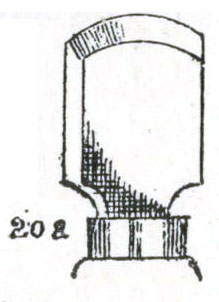
Mezzotint rocker
Further lines can also, of course, be added, and in this case the ground is driven well into the old lines to present their rebiting. It is found that the nearer the lines are laid together the greater the heat engendered by the acid and the quicker the biting. This fact, on which Lalanne laid great emphasis, makes it essential for the etcher to lay his darker lines at a comparatively greater distance from each other that the lighter ones, or confusion would result.
The distinction between an etched and an engraved line in a print seldom presents difficulty. Apart from the greater freedom of character, consequent on the ease which the needle is directed, the etched line near always had rectangular extremities, while the line cut with the graver tapers to a point. An engraved line with blunt extremities is, however, sometimes needed, and is achieved by "cutting back."
Before passing on I may just refer to another method of obtaining prints, which to the cursory observer look deceivingly like etchings. I mean the glass prints produced by some modern etchers which, in reality are not etchings or engravings at all. The process is one of obtaining a print on sensitised paper exposed to the light behind a glass plate which has been prepared by the artist to play the part of a photographic negative, transparencies being left where lines are needed in the print. The essential character of the process puts it quite out of the range of our subject.
The aim of soft-ground etching is the imitation of the texture of a pencil or chalk drawing. Ordinary ground is mixed with about an equal proportion of tallow, and laid on the plate. Thin paper is stretched over the surface of the ground, and the design firmly drawn upon this with a lead-pencil. The paper being removed, the ground is found to adhere where the lines have been drawn in a manner corresponding to the grain of the paper and to the quality of the pencil. The biting is effected by the same method as in ordinary etching.
J. H. Tischbein, the younger, invented another method similar in its results to soft-ground. Powdered crystalline tartaric acid was dusted over the grounded plate before the ground, to which it was to adhere, was hardened. The lines were drawn with a blunt point, which forced the particles through the ground on to the plate. The acid being applied these particles would be dissolved, and so leave way for the biting of an irregular grain. The process has apparently been little used.
Generally regarded as a part of etching, but essentially more allied with line-engraving, is the method called dry-point. A tapering point point (often a solid piece of steel sharpened at either end, as in 17, and of much greater strength than the etching-needle) is drawn firmly across the copper, scratching its line, and causing a burr (as in 6a or 6b according to the inclination of the point), which is much more distinct than that raised by a properly sharpened graver. If, as is generally the case, the burr is left untouched, each line will print with a half-luminous ridge of tone at one or both sides, giving a richness of effect quite foreign to the pure etched line. Very few printings suffice to wear away the burr, which seldom lasts out more than fifteen to twenty-five good impressions. Sometimes, though this is seldom done, the burr is scraped away. There is still something in the delicate sensitiveness of the dry-pointed line which is quite characteristic apart from the tone given by the burr.
The three, processes of line-engraving, etching, and dry-point are frequently intermingled on one plate. Dry-point is constantly used in combination with etching, to complete a lightly bitten plate, or add tone to an etched design. Then both etching and dry-point serve as aids to the line-engraver, and the etcher likewise has occasional recourse to the graver. It is still possible strictly to define an etching from a line-engraving according as the one method subserves or dominates the other. The earliest line-engravers used the one method alone, but in the eighteenth century it was the convention of the line-engraver to start his plate by a light etching of the general features of the design. He then finished with the graver, often alternating engraved lines with the lighter ones first etched. Dry-point has also been used by other line-engravers in place of the preliminary etching.

Engine
By tone-processes we mean those methods whose aim is the attainment of surfaces of tone comparable to a wash of colour, Sometimes the engraver may wish to display the analysed elements of his work, but more generally he aims at an accomplishment which almost hides his method from the casual observer.
We will first describe the crayon (or chalk) manner, taking, as it does, a place midway between the line and tone processes. Its aim is the imitation of the surface texture of the strokes of a chalk drawing. The plate is covered with the etching ground, and this is perforated with various kinds of needles (with one or more points) with the roulette, and other tools of the same genus, and with the mace-head (mattoir), an instrument with a butt-end provided with irregular points (13). The roulette genus includes tools of various forms with a common feature in a revolving circular head. In its simplest form it presents a single serrated edge (10);
or the cutting surface of the wheel may be broader, and dotted or lined in a variety of manners (the form, with an irregular grain, being sometimes called the chalk-roll (11),
because of its common use in this process); while in a third type, called the matting-wheel (12), the head revolves at right angles to the handle.
After etching, the work is often strengthened with the graver, the dry-point, or with the same tools that were used in the etching (roulette, etc.), directly on to the plate. The oval-point is often used for the broader lines. The process is sometimes applied in combination with soft-ground etching, whose aim is analogous.
What is termed the pastel manner is essentially the same process as crayon, only a succession of plates is used to print the various colours in imitation of pastel.
The stipple method is closely allied to the crayon manner, but its imitation of broad surfaces of tone denotes a tone process without qualification. The essential element of stippling is the rendering of tone by a conglomeration of dots and short strokes (or flicks). As in the crayon method, both etching and engraving are brought into play, but a new element in stipple is the use of a graver curved as in 7.
The conventional method is to lightly etch the outline and chief contours, piercing the ground in small holes with the etching-needle (sometimes with two bound together), or with the simple roulette (10). Then the main part of the work is achieved by dotting or flicking with the point of the curved stipple graver, or the dry-point. The simple roulette may also be used directly on the plate, without intervention of the etching ground, as may also the other instruments of the roulette genus which have been already described. Line, is of course, frequently mixed with the dotted work.
With less claim to a separate entity as a branch of engraving than the two preceding, but used in conjunction with others, is the method of dotting, directly on the plate, by means of the hand-punch, or the punch and hammer. It was a traditional method of the goldsmith long before the birth of engraving in our sense, and a considerable number of impressions exist taken at later periods from early goldsmiths' plates engraved in the dotted manner, originally intended only for ornament and not for printing. The dotting-punch with the single point (8a), or with a second point merely used as a gauge, is usually set in a handle and worked by the hand alone (it is the traditional tool of the map and chart engraver). Sometimes the head is flattened, and lined and hatched in the manner of a file (matting-punch, 9) ; this form, and other shapes with two or more heads, are always used with the hammer. The ring-punch (8d), with a hollow circular head, is a common goldsmith's tool, and was often used by the niellists. The punch-method is seldom used alone by the engraver, but is not infrequently found in conjunction with "crayon" or "stipple."
By mezzotint results are obtained in exactly the reverse direction to that of all the other processes of engraving. The artist, having prepared a plate which would print quite dark, proceeds in a negative manner to work out his lighter portions.
The instrument most generally used to prepare the plate is called the rocker (20). Its main element is a curved serrated edge with thread smaller or larger (some 50-100 teeth to the inch), according to the quality of texture required. The rocker is held with its blade at right angles to the plate, and the curved edge rocked regularly over the whole surface at many angles, causing a uniformly indented surface with a burr to each indentation. A proof taken from this would print black, much of the rich quality of the tone coming from the burr. Then with the scraper (23, with two cutting edges, a different shape from the ordinary scraper) the engraver removes those portions of the burr where the lights are to appear, working from dark to light. The more of the surface of the grain that is scraped away, the less will the ink be retained by what remains, and if the scraping and burnishing be continued quite to the bottom of the indentations, a smooth surface will be left, which will hold no ink, and print white. During the last century mezzotint engravers have lessened the arduous labour of preparing the ground by attaching the rocker to a long pole-handle, which can oscillate freely from a moving pivot in any direction. Indications are not wanting, however, to show that some such contrivance of pole and pivot had been known from the very beginning of the art.

Mezzotint burnisher
An earlier method of preparing the plate seems to have been by means of the roulette, and other tools of the same genus, especially the large barrel form with rim, lined and hatched, called the engine (21). The method of the earliest mezzotinters differed very essentially in the fact that it was largely a positive process. They roughened the plate where they required their darks, left the parts which were to appear white untouched by the roulette or "engine," and so scarcely needed to use the scraper at all.
Engraving, etching, and dry-point are sometimes used in combination with mezzotint, and stipple and aquatint are also occasionally added to vary the grain. Such combinations with Other processes, and with other aids, like that of machine ruling, constitute a mixed mezzotint.
Tone effects, similar to those obtained by mezzotint, but of even more regular though less rich texture, are achieved by the aquatint process. Its essential principle is etching through a porous ground formed of sand or of some powdered resinous substance.
There are various methods of laying the ground. The earliest and perhaps the most usually employed is this. Some powdered asphaltum, or resin, is put in a box; this is blown into a cloud with the bellows (or with a fly-wheel worked from without), the plate placed on the floor of the box, and the door shut. The dust settles evenly over the surface, and is fixed to the plate for the biting by the application of heat. Another "dust" method is to shake the powder over the plate from a muslin bag. A very different process is to dissolve the resin in spirits of wine. If this solution is spread over the plate the spirit will evaporate, leaving the dry grain on the plate.
Another method of obtaining a perforated ground was invented and described by Stapart (Paris, 1773), but it has been little used. He sifted sea salt on to a thin coating of ordinary etching ground, which was kept fluid by heat. The grains of salt sink on to the surface of the plate, and, when the ground is hardened, these may be dissolved by application of water, leaving a porous ground ready for the etching.

Mezzotint scraper and cross-section
If any part of the plate is to be completely white this must be protected with the stopping-out varnish. The plate is then put in the acid and left to bite just as deeply as is required for the lightest portions. It is then removed ; the parts which are now bitten to the required depth, are covered with varnish, and the plate is returned to the bath. The process is repeated as often as needed, the portions that are to print darkest naturally having most bitings
Similar effects to ordinary aquatint can be obtained by various other methods, such as that of passing the grounded plate through the press in conjunction with sand-paper. This causes a slight burr on the plate, but the main effect is attained by biting through the etching ground which has been pierced in the process. In work with these methods the scraper may have to be brought into play. Analogous effects of great variety may also be achieved by pressing textiles through the ground.
The grain on the plate may also be corroded by means of sulphur. The plate is spread with oil, and powdered sulphur is dusted on to this. The particles will slowly eat away a very delicate grain. Then a delicate grain may be achieved by merely leaving the acid on the surface, or on parts of the surface of the plate, where required, either by means of feathering or by immersion. Examples of this may be noted quite early in our history, e.g. in two plates of Daniel Hopfer (B. 16 and 90), and recent etchers have not infrequently applied the same practice.
Since the end of the eighteenth century machine ruling has been Mechanical very largely used in one form or another by commercial engravers, methods. Many of the line engravers of the latter part of the eighteenth and beginning of the last century used it largely for their skies, and for other regular surfaces in the shading. By complicated ruling machines the grains of mezzotint, of aquatint, and of the various tone processes can be closely imitated.
A common practice, or fad, which dates from the end of the seventeenth century may just be mentioned. I mean that of laying specially treated paper impressions (of either mezzotint, stipple, or what not) on glass, rubbing away the paper behind, leaving just the slightest film with the print, and then colouring at the back by hand. Seen in frames and in a bad light, glass coloured prints of this description often belie their real nature and pass as paintings.

Gouge or scooper
Edward Orme had a special method of using varnishes which rendered the paper transparent wherever applied, avoiding the delicate process of rubbing away the paper. Charles Turner produced many prints to be treated in this manner.
Some recent engravers have used a process by which a print taken from a metal plate has something of the appearance of a mezzotint or aquatint, though the plate has not in reality been engraved at all. The method involves painting the subject in oils on the surface of the plate, either directly or by the reverse process of first covering completely, and then rubbing out the light by finger or brushes, etc. An impression is pulled from this either by hand pressure or in the printing press, and as only one impression can be taken they have been called monotypes. The process chiefly belongs to the last twenty years, but its essential element, that of painting transferred in the press, had been occasionally used by earlier engravers, e.g. by Castiglione and William Blake. Sir Hubert von Herkomer has developed the same idea further, making a metallic mould or electrotype from a plate similarly painted and dusted with powder to add a certain granulation to the surface. Impressions can be taken from this electrotype just as from an ordinary engraving. It is a method of reproducing what is really a painting without the aid of photography, as in photogravure and the other mechanical processes.
As the artist-engraver is quite often his own printer, we will briefly state the elements of a process which can be finessed into a real art, and one on which the successful realisation of the engraver's idea depends in a large degree.

Flat punch (top) and
cocking punch (bottom)
Some printer's ink is first laid on the plate and pressed into the lines by means of a dabber, similar in principle to that used for laying the etching ground. The superfluous ink is then rubbed from the surface of the plate By printing muslin, and the rubbing generally finished with the palm of the hand (coated with a thin layer of whitening). The plate is either rubbed quite clean, or more or less ink may be left on the surface, just where the engraver wishes to add a tint. A certain softness of effect is gained by what is called retroussage. Some fine muslin is passed lightly over the plate, just touching the surface. In this motion the stuff catches a portion of the ink, and, drawing it slightly upwards, leaves a certain quantity on the edges of the lines, which consequently lose the harshness of definition in the printing. By the same means ink may be drawn out of the lines, and spread as an even tint over the whole plate.
A sliding board which passes between two rollers is the essential feature of the copper-plate press. The paper is placed damp against the plate, and pulled through the press underneath layers of special blankets. In the case of wood-cuts and all relief-blocks the ink is merely taken from the surface, and the ordinary printing press with its perpendicular motion is sufficient for the comparatively small pressure required. In copper-plate printing, on the other hand, the pressure must be strong enough to force the paper into the hollows, and so pull out the ink.
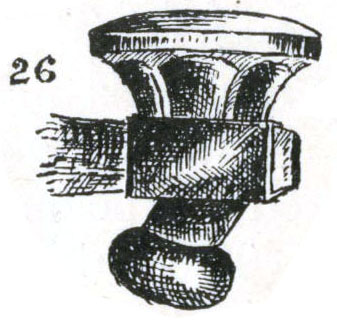
Engraver's hammer
From the presence of hole marks in impressions of not a few early prints — more especially Italian — it seems that at the earliest period of engraving, before the full development of the copper-plate press, the plate may have been sometimes pinned to a block, just as we know was done in the case of metal cuts. In other cases, when early impressions are known without the holes, we may assume that these were made at some period to fix the plate to some article of furniture or decoration to serve as ornament.
It must be remembered that it is the common practice of the goldsmith to obtain test impressions by hand. These would be best taken by rubbing with the burnisher, or with some similarly shaped instrument, a layer of smooth paper being generally sufficient cover to protect the damp paper on the plate. The thin and unequal quality of certain of the earliest prints may perhaps be sometimes explained by the assumption of printing by hand pressure.
The plate has to be refilled with ink between each impression. Sometimes the last vestiges of ink are pulled out by taking another impression, of course perfectly valueless in itself, which goes by the name of maculature.
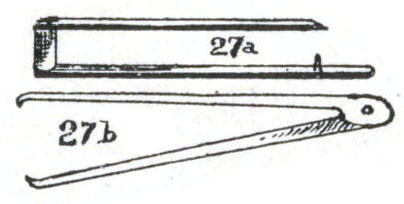
Calipers
Occasionally a proof is taken, not from the plate itself, but from an impression on paper while the ink is still damp. Such counterproofs, which of necessity look weak and thin, and have no artistic value, are taken with the idea of having a print where the work appears in the same direction as on the plate itself, either for the sake of mere comparison with the latter, or as an aid to the engraver in making corrections or additions on the copper.
For the various methods of printing in colour we would reserve our remarks to a special section in Chapter IX.

Oil rubber
It goes without saying that the work on the plate is gradually worn down through the printing. The number of good impressions which can be taken is a very uncertain quantity, varying in accordance with the quality of the engraving. Both dry-point and mezzotint, depending as they do for their quality on the delicate burr, yield few brilliant impressions, often not more than some fifteen to twenty-five. We have noticed the fact that steel-facing is frequently used to-day to harden the surface. But even with this protection, in the case of delicate work like mezzotint, good impressions would still be limited to a hundred or so. From a line-plate, however, under the same condition, two or three thousand might be taken without great apparent deterioration. Without steel-facing, copper-plates of line-engravings and pure etchings might be made to yield one, two, or even three thousand impressions, but the deterioration is constant, and the last prints would be mere ghosts of the original composition.
The amateur should bear in mind that an impression on which the plate-mark (i.e. the limit of the impress caused by the printing) has been cut away (what is called "clipped") does not possess the value which attaches to a perfect print. One must remember, however, before branding a print as a clipped impression, that paper of a certain quality never retains the marks of the impress. The presence of the plate-line is also a sure test to distinguish an engraving from a woodcut or a lithograph, a matter which in occasional instances is not without difficulty.
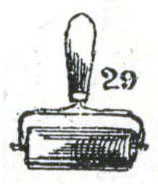
Roller
The word state is applied to the separate stages through which a print passes when new work is added on the plate itself. The immense differences which can be made by printing with more or less ink on the surface never constitute a state, merely a variant impression. Besides definite changes in the work on the plate, the addition of the engraver's or designer's signature, address of publisher, and of the title (either scratched, or in clear engraved lettering), are all regarded as elements constituting states. The practice of remarque proofs, constituted by the presence of the "remarque" (as the subsidiary sketch in the margin is termed), largely emanates from the printseller of reproductive engravings and etchings of the last century, and is as inartistic in idea as it is commercial in spirit. A late impression need not be even a second state if no change has been made on the copper itself, while a comparatively early impression might quite well be a late state (say fifth or sixth) if the engraver has taken only one or two proofs from the plate in its earlier states, to guide him towards the development of his idea. Thus later states may be just as good from an aesthetic standpoint as early proofs, which from their very rarity command much higher prices.
The work of the engraver is generally indicated by one of the Latin words sculp(sit), caelavit or incidit; and of the etcher by f[ec(it)] [aqua forti] The student must be wary, however, in his inferences, as there are examples, more particularly in the sixteenth and seventeenth centuries, where the line-engraver uses fecit and the etcher sculpsit. The confusing mixture of processes in the line work of artists such as Callot, Bosse, J. van de Velde, etc., may account in some instances for the looseness of application. Pinxitt) and delin(eavit) are the usual predicatives of the painter and draughtsman respectively, inven(it) and composuit being also used in reference to the author of the design. Figuravit generally refers to a drawing having been made as the immediate basis for the print (often by the engraver himself), after the original composition of another artist. If the publisher's or printseller's name is given, it is generally followed by exc(udit), divulgavit, or formis, the printer's by imp., though this seldom occurs except in manuscript.
In estimating the age of an impression, some knowledge of the various qualities of paper is of service, but it must be combined with the qualifying recognition that old hand-made paper (possibly as much as two or three centuries old) has always been much sought after and used for its quality by many modern engravers and etchers. The earliest engravers most commonly used ordinary linen-rag paper with a regular grain, not too opaque in quality.

Dabber
Towards the beginning of the seventeenth century Indian and Japanese papers were beginning to be imported into Europe. The former, usually thin in texture, is of a white though dull surface, and prints much more cleanly than the latter. The Japanese paper is far more absorbent, and needs in consequence to be printed from a plate not too fully charged with ink. With its rich yellow tone and silky surface, it is an excellent paper where a delicate surface tint without sharp definition of line is required. Rembrandt used it largely, as have most etchers since his day. The paper used in the first half of the nineteenth century is generally the worst of all; it frequently displays its bad quality by turning colour in spots. This spotty discoloration of the paper — "foxing," as it is called— is as varied in its character as in its causes. It may be of animal or of vegetable growth, or even of mineral origin, arising from the composition of the paper, the nature of the ink, the dampness and impurities of the surrounding atmosphere, and a host of other causes. While the commoner forms may be removed by the simplest remedies, great care, as well as considerable scientific knowledge, is required by the restorer who is effectively to check each kind of growth. A thick card-like paper was also first used at the beginning of the nineteenth century, often a good sign of a more modern impression from an eighteenth century mezzotint. Vellum, whose manufacture goes back many centuries before that of paper, has been occasionally used at all periods. For large prints its rich quality is extremely powerful and effective. The manner in which it shrinks sometimes renders the identity of a vellum impression a puzzling matter. Even the great iconographer Baitsch did not avoid the pitfall, giving a separate description in his catalogue of Rembrandt to a shrunk vellum impression of a plate described in another number.
Paper- marks, indicating a standard quality, or less often a particular factory, may be of occasional service in locating the origin and limiting the date of early prints, but the manner in which paper must have been transferred from one country to another, and the uncertainty of interval between manufacture and use, necessitate many reservations and qualifications in accepting this type of evidence.
It may be added that impressions are sometimes taken on other materials besides paper and vellum, e.g. on satin or silk. In the eighteenth century this is by no means uncommon, but it is difficult to set any limits to the period of the practice of printing on textiles, which, in the case, of wood-blocks, was undoubtedly in use in Europe as early as the twelfth century.
Some of my readers may be surprised to learn that engraving and etching were so closely related. Please see Gene Hessler's book, The Engraver's Line, (pages 4 to 7) for more on this subject. Mr. Hessler even included custom recipes for etching acid from line engravers like Lorenzo Hatch and James Smillie.